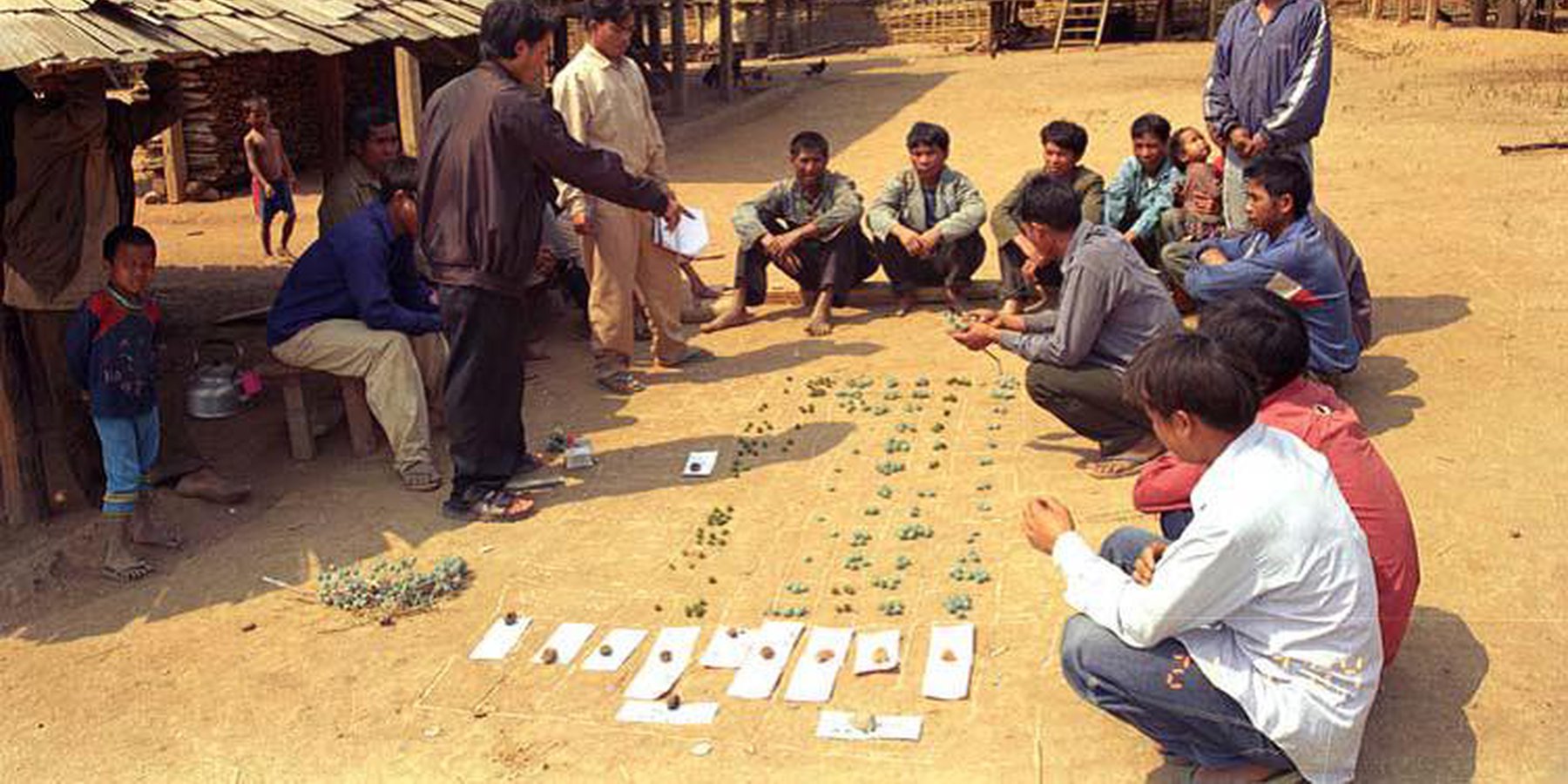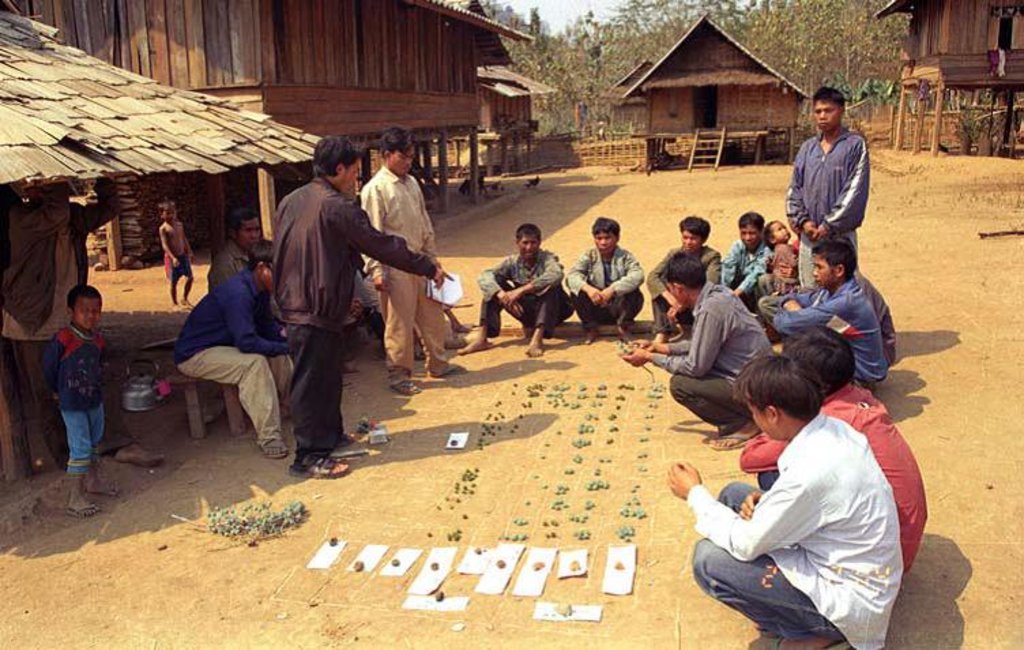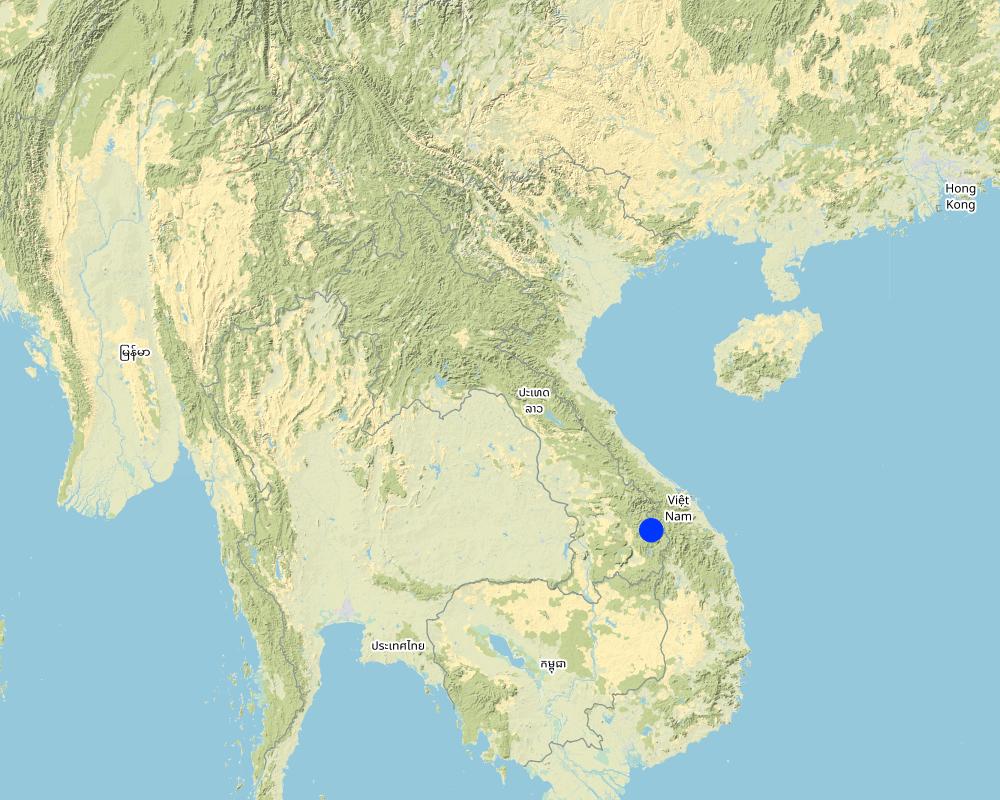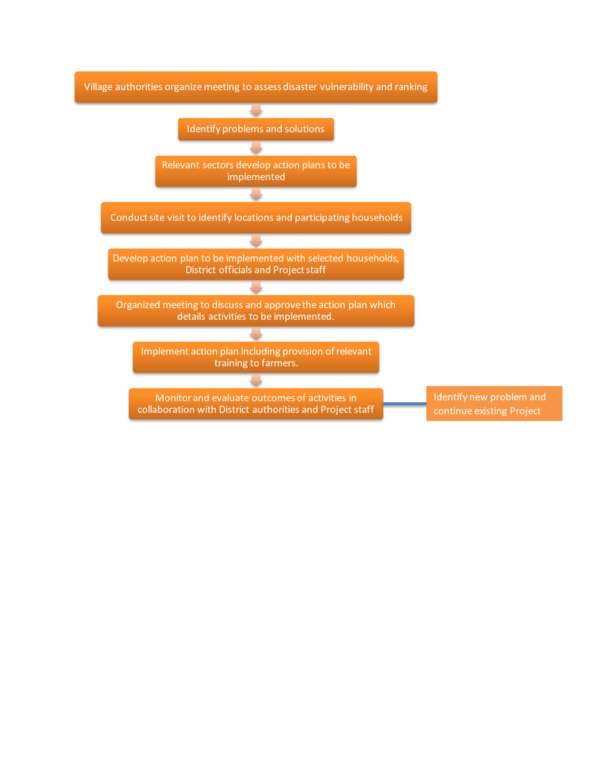Village Capacity and Vulnerability Assessment Project on Disaster Management [Laos, República Democrática Popular de]
- Creación:
- Actualización:
- Compilador: Pasalath Khounsy
- Editores: Bounthanom Bouahom, viengsavanh phimphachanhvongsod, kang phanvongsa
- Revisores: Nicole Harari, William Critchley, Joana Eichenberger
approaches_3877 - Laos, República Democrática Popular de
Visualizar secciones
Expandir todo Colapsar todos1. Información general
1.2 Detalles de contacto de las personas de referencia e instituciones involucradas en la evaluación y la documentación del Enfoque
Persona(s) de referencia clave/s
Project manager:
Phasaveng Phounsy
+856 030 211582
phounsy.phasaveng@careint.org
CARE Office in Saravan
Laos, República Democrática Popular de
Nombre del proyecto que facilitó la documentación/ evaluación del Enfoque (si fuera relevante)
Scaling-up SLM practices by smallholder farmers (IFAD)Nombre de la(s) institución(es) que facilitaron la documentación/ evaluación del Enfoque si fuera relevante)
National Agriculture and Forestry Research Institute (NAFRI) - Laos, República Democrática Popular de1.3 Condiciones referidas al uso de datos documentados mediante WOCAT
¿Cuándo se compilaron los datos (en el campo)?
25/08/2017
El compilador y la/s persona(s) de referencia claves aceptan las condiciones acerca del uso de los datos documentados mediante WOCAT :
Sí
2. Descripción del Enfoque MST
2.1 Breve descripción del Enfoque
The project is aimed at capacity building in disaster emergency response at district and village levels. It has applied a participation approach in planning and implementation. This included the identification of problems, SWOT analyses, implementation, and monitoring.
2.2 Descripción detallada del Enfoque MST
Descripción detallada del Enfoque MST:
Since 2012, after the Ketsana typhoon hit the southern provinces of Lao PDR, CARE International in Xekong Province has initiatives that address disaster reduction which are funded through various sources. The project is aimed at capacity building in disaster emergency response at district and village levels. DarkCheung district, one of the poorest districts of Xekong province, has established a Disaster Management Unit in five villages. The project was supported by Luxembourg’s Ministry of Foreign Affairs, Debeco, through the European Union. Most of the projects were relatively small and short duration, with approximately 2-3 years of project implementation. In 2017, Care International has also followed up existing activities with support from Debeco which are implemented in the three districts of Kaleum, DarkCheung, and Lamam, covering 16 villages. The aspects of the work that are relevant to the district office of agriculture include Disaster Vulnerability Assessment and Village Capacity Building. The main objectives of the project are to increase capacity in disaster management within local communities; increase food security, gender equality promotion in cooperation with local authorities, and increase awareness about disaster prevention. In principle, the project applied a participatory approach in planning and implementation. This included the identification of problems, SWOT analyses, implementation, and monitoring. The village and district authorities, as well as farmers, have been actively involved in project activities. It should be noted that the district authorities played an active role in community development. However, challenges remain, as Care International in Xekong province developed only short term projects, and this may affect outcomes and continuity of objectives in the future.
2.3 Fotos del Enfoque
2.5 País/ región/ lugares donde el Enfoque fue aplicado
País:
Laos, República Democrática Popular de
Región/ Estado/ Provincia:
Sekong Province
Especifique más el lugar :
Kaluem, Darkchueng and Lamam district
Comentarios:
CARE International Office in Sekong province
Map
×2.6 Fechas de inicio y conclusión del Enfoque
Indique año del inicio:
2014
Si no se conoce el año preciso, indique la fecha aproximada en la que se inició el Enfoque:
hace menos de 10 años (recientemente)
2.7 Tipo de Enfoque
- proyecto/ basado en un programa
2.8 Propósitos/ objetivos principales del Enfoque
1. Strengthen capacity on disaster management at local levels;
2. Increase food security;
3. Promote gender equality amongst the local authorities; and
4. Increase awareness on disaster prevention.
2.9 Condiciones que facilitan o impiden la implementación de la/s Tecnología/s aplicadas bajo el Enfoque
normas y valores sociales/ culturales/ religiosos
- impiden
Unsafe birth, gender and other issues are sensitive and need careful approach and understanding.
disponibilidad/ acceso a recursos y servicios financieros
- impiden
entorno institucional
- facilitan
colaboración/ coordinación de actores
- facilitan
Good cooperation and participation in implementation of activities amongst the villagers
marco de trabajo legal (tenencia de tierra, derechos de uso de tierra y agua)
- facilitan
políticas
- facilitan
gobernanza de tierras (toma de decisiones, implementación y aplicación)
- facilitan
conocimiento de MST, acceso a apoyo técnico
- facilitan
Better coordination and understanding of district officials and village people.
mercados (para comprar insumos, vender productos) y precios
- impiden
carga de trabajo, disponibilidad de mano de obra
- facilitan
3. Participación y roles de las partes interesadas involucradas
3.1 Partes interesadas involucradas en el Enfoque y sus roles
- usuarios locales de tierras/ comunidades locales
Villagers or head of household participating in activities
Implementation, labour and material contribution as project needed
- organizaciones comunitarias
Village authorities
Provide socio-economic information, encourage villagers to participate in the project
- especialistas MST/consejeros agrícolas
CARE International staff in Xekong Province
- ONG
CARE, Oxfam, Save the Children, French Redcross
- gobierno local
Provincial, district coordinators and technical staffs
Facilitate the coordination and strengthening local authorities and communities
3.2 Involucramiento de los usuarios locales de tierras/ comunidades locales en las distintas fases del Enfoque
| Involucramiento de los usuarios locales de tierras/ comunidades locales | Especifique quién se involucró y describa las actividades | |
|---|---|---|
| iniciación/ motivación | interactivo | The village, district, provincial authorities, and project staff to identify and assess disaster vulnerability and ranking in communities. |
| planificación | interactivo | The village, district, provincial authorities, and project staff involved in problem analysis and identified solutions, conducted site visits in the project location with participating households. Develop action plan, organize meeting to discuss and approve project activities. |
| implementación | interactivo | The village, district and provincial authorities in collaboration with project staff provided training and implemented project activities together with farmers in target villages. In case of significant activity such as infrastructure development, the project staff will assist in the implementation. |
| monitoreo y evaluación | interactivo | All concerned stakeholders were involved in project monitoring in each phase. |
| interactivo | Allow each stakeholders summarize project implementation outcomes, and discuss issues and identify solutions for future actions. |
3.3 Flujograma (si estuviera disponible)
3.4 La toma de decisiones en la selección de Tecnología(s) MST
Especifique quién decidió la selección de las Tecnología/ Tecnologías a implementarse:
- todos los actores relevantes, como parte de un enfoque participativo
Especifique las bases que sustentaron la toma de decisiones:
- la evaluación de conocimiento MST bien documentado (la toma de decisiones se basa en evidencia)
- la experiencia personal y opiniones (no documentadas)
4. Apoyo técnico, fortalecimiento institucional y gestión del conocimiento
4.1 Construcción de capacidades / capacitación
¿Se proporcionó la capacitación a usuarios de tierras/ otras partes interesadas?
Sí
Especifique quién fue capacitado:
- usuarios de tierras
- personal de campo/ consejeros
Forma de capacitación:
- en el contexto de trabajo
- de agricultor a agricultor
- reuniones públicas
- cursos
Temas avanzados:
General knowledge on disaster prevention, disaster preparedness and emergency response, forest and environmental protection
4.2 Servicio de asesoría
¿Los usuarios de tierras tienen acceso a un servicio de asesoría?
Sí
Especifique si servicio proporcionado se realizó:
- en los campos de los usuarios de tierras
Describa/ comentarios:
In addition, there were monitoring missions from village, district and provincial authorities. In case of an emergency situation, coordination was through mobile phones.
4.3 Fortalecimiento institucional (desarrollo institucional)
¿Se establecieron o fortalecieron instituciones mediante el Enfoque?
- sí, moderadamente
Especifique el nivel o los niveles en los que se fortalecieron o establecieron las instituciones:
- local
Describa la institución, roles y responsabilidades, miembros, etc.
There were monitoring teams representing the village and district, and a village notice board.
Especifique el tipo de apoyo:
- financiero
- construcción de capacidades/ entrenamiento
- equipo
4.4 Monitoreo y evaluación
¿El monitoreo y la evaluación forman parte del Enfoque?
Sí
Comentarios:
The CARE -Xekong M&E team collaborated with the through use of village notice boards in the village and district.
Si respondió que sí, ¿la documentación se utilizará para monitoreo y evaluación?
No
4.5 Investigación
¿La investigación formó parte del Enfoque?
No
5. Financiamiento y apoyo material externo
5.1 Presupuesto anual para el componente MST del Enfoque
Si no se conoce el presupuesto anual preciso, indique el rango:
- 100,000-1,000,000
Comentarios (ej. fuentes principales de financiamiento/ donantes principales):
Multiple funding sources including Debego for humanitarian aid, European Union (EU), Ministry of Foreign Affairs of Luxembourg
5.2 Apoyo financiero/material proporcionado a los usuarios de tierras
¿Los usuarios de tierras recibieron financiamiento/ apoyo material para implementar la Tecnología/ Tecnologías? :
No
5.3 Subsidios para insumos específicos (incluyendo mano de obra)
- mano de obra
| En qué grado | Especifique los subsidios |
|---|---|
| totalmente financiado |
Si la mano de obra de usuarios de tierras fue un insumo sustancial, ¿fue:
- voluntario?
Comentarios:
Project provided lunch and villagers shared labour
5.4 Crédito
¿Se proporcionó crédito bajo el Enfoque para actividades MST?
No
5.5 Otros incentivos o instrumentos
¿Se usaron otros incentivos o instrumentos para promover la implementación de Tecnologías MST?
No
6. Análisis de impacto y comentarios de conclusión
6.1 Impactos del Enfoque
¿El Enfoque empoderó a los usuarios locales de tierras, mejoró el involucramiento de las partes interesadas?
- No
- Sí, un poco
- Sí, moderadamente
- Sí, mucho
The project has strengthened local communities to work together from planning, implementing, and monitoring approaches.
¿El Enfoque ayudó a los usuarios de tierras a implementar y mantener Tecnologías MST?
- No
- Sí, un poco
- Sí, moderadamente
- Sí, mucho
¿El Enfoque mejoró la coordinación e implementación efectiva en costos de MST?
- No
- Sí, un poco
- Sí, moderadamente
- Sí, mucho
¿El Enfoque movilizó/mejoró el acceso a recursos financieros para implementar MST?
- No
- Sí, un poco
- Sí, moderadamente
- Sí, mucho
¿El Enfoque mejoró el conocimiento y capacidades de los usuarios para implementar MST?
- No
- Sí, un poco
- Sí, moderadamente
- Sí, mucho
¿El Enfoque mejoró el conocimiento y capacidades de otras partes interesadas?
- No
- Sí, un poco
- Sí, moderadamente
- Sí, mucho
¿El Enfoque construyó/ fortaleció instituciones, colaboración entre partes interesadas?
- No
- Sí, un poco
- Sí, moderadamente
- Sí, mucho
¿El Enfoque mitigó conflictos?
- No
- Sí, un poco
- Sí, moderadamente
- Sí, mucho
¿El Enfoque empoderó a grupos en desventaja social y económica?
- No
- Sí, un poco
- Sí, moderadamente
- Sí, mucho
The project has assisted the disabled groups, divorced women with many children, households with lack of productive labours who were all prioritized as project beneficiaries.
¿El Enfoque mejoró la equidad de género y empoderó a las mujeres y niñas?
- No
- Sí, un poco
- Sí, moderadamente
- Sí, mucho
The project has increased awareness on women’s rights.
¿El Enfoque alentó a jóvenes/ la siguiente generación de usuarios de tierras a involucrarse con MST?
- No
- Sí, un poco
- Sí, moderadamente
- Sí, mucho
¿El Enfoque mejoró cuestiones de tenencia de tierra/ derechos de usuarios que obstaculizaron la implementación de la Tecnologías MST?
- No
- Sí, un poco
- Sí, moderadamente
- Sí, mucho
¿El Enfoque resultó en mejor seguridad alimentaria/ mejoró la nutrición?
- No
- Sí, un poco
- Sí, moderadamente
- Sí, mucho
¿El Enfoque mejoró el acceso a los mercados?
- No
- Sí, un poco
- Sí, moderadamente
- Sí, mucho
The project activities are linked to food security.
¿El Enfoque llevó a un acceso mejorado a tierra y saneamiento?
- No
- Sí, un poco
- Sí, moderadamente
- Sí, mucho
After the Ketsana typhoon, the project has supported the repair of 3 – 4 gravity fed water supply systems in 16 villages.
¿El Enfoque llevó a un uso más sostenible/ fuentes de energía?
- No
- Sí, un poco
- Sí, moderadamente
- Sí, mucho
The project has suggested the use of solar voltage power systems in areas without connection to main power grids in 10 villages in Kaleum and DarkCheung district
¿El Enfoque mejoró la capacidad de los usuarios de tierras a adaptarse a los cambios climáticos/ extemos y mitigar desastres relacionados al clima?
- No
- Sí, un poco
- Sí, moderadamente
- Sí, mucho
¿El Enfoque llevó a oportunidades de empleo, ingresos?
- No
- Sí, un poco
- Sí, moderadamente
- Sí, mucho
6.2 Motivación principal del usuario de la tierra para implementar MST
- reducción de la degradación del suelo
- reducción del riesgo de desastres naturales
- conciencia medioambiental
- conocimiento y capacidades mejorados de MST
6.3 Sostenibilidad de las actividades del Enfoque
¿Pueden los usuarios de tierras sostener lo que se implementó mediante el Enfoque (sin apoyo externo)?
- sí
Si respondió que sí, describa cómo:
The district and village authorities have some basic understanding about disaster responses.
6.4 Fortalezas/ ventajas del Enfoque
| Fuerzas/ ventajas/ oportunidades desde la perspectiva del usuario de la tierra |
|---|
| Strengthening capacity of village, district and provincial authorities (Committees for Disaster Prevention and Control) particularly after Ketsana typhoon. |
| Communities gain knowledge and are able to identify problem and develop action plans on disaster management. |
| The project has implemented activities that provided benefits to the public such as: disaster warning, rainwater storage, precipitation station. |
| Supported high frequency radio system instead of mobile phones. |
| Fuerzas/ ventajas/ oportunidades desde la perspectiva del compilador o de otra persona de referencia clave |
|---|
| Disaster management is an important aspect that needs to be implemented in all regions. |
| Local communities and other stakeholders were actively participated in the project. |
| The project helped to identify key problems and strengthen capacity to ensure regular and continuous monitoring of activities although it had only one-year lifespan. The project adopted M&E framework from similar projects in order to effectively monitoring this project. |
6.5 Debilidades/ desventajas del Enfoque y formas de sobreponerse a ellos
| Debilidades/ desventajas/ riesgos desde la perspectiva del usuario de la tierra | ¿Cómo sobreponerse a ellas? |
|---|---|
| The disaster management projects had short term lifespan but there were considerable needs and expectations from communities, and the lack of sufficient funding. | |
| The MOU signing process for disaster related projects took long time between the government and NGOs which caused delayed in project implementation. | The need to have better coordination on the review and approve the MOU document between the two parties. |
| Debilidades/ desventajas/ riesgos desde la perspectiva del compilador o de otra persona de referencia clave | ¿Cómo sobreponerse a ellas? |
|---|---|
| The GOL has yet identified vulnerable areas to certain disasters and there are still a lack of funding allocation to meeting the needs. | The need to identify appropriate vulnerable areas including high vulnerability, warning areas and among others. |
| Most projects were managed by non-profit organizations and typically have short-term lifespan and limited staff. | The need to develop long-term planning with multi-funding organizations. |
7. Referencias y vínculos
7.1 Métodos/ fuentes de información
- entrevistas con especialistas/ expertos en MST
2
Vínculos y módulos
Expandir todo Colapsar todosVínculos
No hay vínculos
Módulos
No se hallaron módulos





